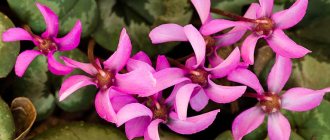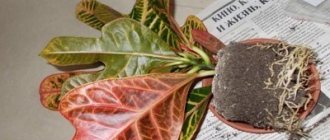Quote from Marcel20111
Read in full In your quotation book or community!
Croton, or codiaum. Proper care.
Codiaeum has about 14 species and belongs to the Euphorbiaceae family.
In nature, they are distributed on the islands of the Pacific Ocean and the Malay Archipelago and Northern Australia. The genus name Codieum comes from the Greek word "kodeia" - head. Croton is a variegated tree that is an evergreen shrub with leathery leaves of different shapes in different species. The decorative effect of croton is expressed in the foliage. The leaves are large oval with a smooth edge, long ribbon-shaped, elongated, with a pointed angle and fan-shaped. vk.com/life.flowers In general, the crown of the bush is colored unevenly: young leaves located at the top are usually green, but as they age they become yellow, red, and brown. The leaves may be variegated with yellow spots on a green background or with veins that differ in color from the leaf. Croton has the characteristic characteristic of all euphorbias, at the slightest mechanical damage to any of its organs, to secrete white milky juice, which heals the injured surface, drying it out and protecting it from the influence of external factors. In the wild, the shrub grows up to three meters; at home, as a rule, it does not exceed one meter. It grows slowly and for a long time, sensitively takes root in a new place. It blooms rarely, inexpressively. Small white flowers are collected in racemes and appear in indoor conditions quite rarely. It is recommended to remove the inflorescences immediately after they form, so as not to tire the plant. It is believed that the plant cleanses the house of negative energy and is creative, putting the environment in order. Lighting. Codiaums, or crotons, prefer bright, diffused light; they require protection from direct sunlight. Places near eastern and western windows are best suited for growing; near southern windows, it is necessary to provide shading from direct sunlight; near the northern window, codiaums may not have enough light. With a lack of light, variegated leaves lose their wonderful color. Variegated codiaums need more light than green-leaved ones, but they also need protection from direct sunlight. In winter, provide the brightest possible location. Temperature. Plants require a fairly high and uniform temperature (20-22°C in summer and not lower than 18°C in winter). Croton does not tolerate drafts or significant temperature fluctuations, so it cannot be placed on an open balcony. At low temperatures, the leaves curl and turn brown. Watering and air humidity. Codiaums are watered all year round regularly and abundantly, with soft, lukewarm, settled water, as the top layer of the substrate dries. It is necessary to avoid stagnation of water in the pan. To prevent acidification of the soil in the pot, use a small and cramped container so that the roots quickly master the earthen ball, but it must be watered regularly, preventing the earthen ball from drying out.vk.com/life.flowers The plant needs high air humidity. The plant must be regularly sprayed with soft, settled water, but remember: if you have exposed the plant to direct sunlight, you cannot spray it at this time. A warm shower once a month is helpful. To protect against dry air, you can place the pot with it in a tray with expanded clay or pebbles, kept constantly moist, but the bottom of the pot should not touch the water. Fertilizers. Feeding of codiaums is carried out once every two weeks in the summer and once a month in the winter. It is better to use organic matter; high doses of mineral fertilizers can stimulate the growth of ugly, gnarled leaves. Microelements are very useful, but excess nitrogen can lead to loss of the characteristic variegated color. Fertilizers for cacti or succulents are suitable. Formation. To form a beautiful crown, codiaums require proper and regular pruning. It is recommended to pinch the young plant. The first is done when the plant reaches a height of 10-15 cm, then, as the shoot grows, every 20 cm, on the outer bud. Transfer. Codiaums are replanted in the spring, young ones annually, large overgrown specimens are replanted or transferred every 2-3 years, adding fertile substrate to a larger pot. The soil. The substrate is suitable rich in humus, slightly acidic (pH about 5.5). The planting mixture can be made up of turf, leaf, humus soil, peat and sand in equal proportions with the addition of pieces of charcoal. Ready-made soil for cacti is suitable. Good drainage is necessary. vk.com/life.flowers The plant is suitable for hydroponic culture. Reproduction. Codiaums are propagated by seeds and cuttings. Seed propagation is rarely used, mainly in hybridization work. Plants are easily propagated by cuttings, and this method is widespread. Cuttings are taken mainly in January-April, but cuttings are practically possible throughout the year. The tops of the shoots, as well as semi-lignified pieces of the shoots, are cut off for cuttings. After cutting the cuttings, milky juice flows out, so before planting it is necessary to wash them in warm water. The surface of fresh cuts is sprinkled with crushed coal. It is recommended to use the growth stimulator heteroauxin. Cuttings are planted in a distribution box or 1 copy in 7-centimeter pots. The substrate for planting cuttings is sand, but more often a mixture of sand and peat soil. Can be rooted in water. The temperature for cuttings needs to be at least 24C. Caring for cuttings consists of spraying and maintaining substrate moisture. Rooting occurs within 1-1.5 months. After rooting, the cuttings are planted in 7-8 cm pots. Composition of the soil: leaf - 1 tsp, humus - 1 tsp, peat - 1 tsp, turf - 1 tsp, sand - 1 tsp. vk.com/life.flowers After entwining the earth with roots, transshipment is carried out at 10-11 -centimeter pots. Precautionary measures. The sap of the plant is poisonous and can cause vomiting, diarrhea, and contact dermatitis. Care must be taken when performing any operation. Upon completion of work, you must wash your hands with soap. Possible difficulties: Due to lack or excess of light, the leaves lose color. Due to direct sunlight, burns appear on the leaves. Due to dry air or soil, the tips of the leaves turn brown; if the temperature is too low, the edges of the leaves turn brown. For the same reasons, the lower leaves fall off. Brown tips of the leaves indicate a lack of moisture in the substrate and in the air, and if the edges of the leaf blade are also colored this color, it is necessary to increase the ambient temperature. Large leaves easily adsorb dust, and they are wiped with a soft, damp sponge at least 2-3 times a decade. vk.com/life.flowers With low air humidity, codiaum is easily attacked by pests and diseases. At a temperature of 12°C, dulling of the surface of the leaves is observed, and with a long stay at 10-12°C, the leaves crumble. Young leaves are less brightly colored than older leaves. This is normal for the plant. Damaged by: mealybugs, spider mites, scale insects, thrips.
A flower with leaves like an oak tree - an unsurpassed croton
Our mother nature is rich in different plants and each of them is unique. At the same time, quite often you can find cultures that are very similar to each other, for example, even the giant oak tree has an interesting double. It is noteworthy that a flower with leaves like an oak tree is also a tree, only very small and is an original indoor plant. The only similarity between them is the shape of the leaf blades, although it is very distant. At the same time, many gardeners remember the flower precisely for this reason. What kind of culture is this and what is so special about it?
Tall indoor plants
Tall indoor plants include several particularly popular species that can be used to decorate home or office interiors. Among the “giants” there are varieties of palm trees, ficus, hibiscus, etc.
Palm trees
A non-flowering option for tall plants for a room is the palm tree. There are several types that can be placed indoors:
- Arecaceae;
- Kentia palm;
- Ponytail palm.
Huge palm tree in the interior of the room
There are other types, types of indoor palm trees that will fit into the design of the room or will decorate a winter garden or greenhouse.
Note! A palm tree can have a bush-like or tree-like trunk, much depends on its natural habitat.
Ficus
Ficuses have many varieties, among which there are specimens reaching a height of more than 1.5 m. This plant is valued for its unpretentiousness and high degree of survival in any conditions. The most outstanding option among ficus trees in terms of growth is the rubber tree.
Flower with leaves like oak
Indoor oak - this is what croton, a plant from the euphorbia family, is sometimes called.
You don’t need to look far for the reason, because its leaves really look like oak. Croton grows in the form of a compact tree up to a maximum of 1 m in height. But to see its lush crown, you will have to wait more than one year, since the bush develops slowly. Only the shapes of the plates are remotely similar to oak. In decorative deciduous croton they have a denser structure and brighter color. The Latin name for croton is codiaum. It is noteworthy that it first forms green young leaves. They acquire variegation over time as they age.
Croton gained its popularity due to its varied and bright colors. The flower has about 14 varieties, and each of them, in turn, is distinguished by its originality and has many varieties. Most often in indoor floriculture you can find the following varieties of croton:
- Petra with green leaves and yellow veins;
- Miss Iceton with yellow-red-pink variegated leaves;
- Normal - with red veins and yellow spots on green leaves;
- Gold Finger with narrow green-yellow leaves.
Croton Excelent is the most similar to oak with its leaves. It has an interesting color with multi-colored veins on a yellow-green plate. Interestingly, on the reverse side the leaf takes on a purplish hue.
Features of growing croton
In general, the plant is not particularly whimsical, but it still has some requirements. The flower loves bright but diffuse lighting and, if there is not enough light, loses its color saturation. The evergreen croton has no rest period, and in winter it feels great at 18°C.
But the variegated bush does not like drafts and cold and begins to shed its leaves.
Increased plant requirements for humidity. It should be watered abundantly and regularly, and also maintain high air humidity. But at the same time, it is important to ensure that the water does not stagnate, otherwise the root system will begin to rot. Twice a month you can apply special complex fertilizers for decorative deciduous plants. Feeding in winter will not hurt, but once a month is enough. In order for the bush to grow lush, it is recommended to pinch the growth points every 20 cm.
Transplantation of codiaums
Varietal crotons are replanted at the same time as most indoor plants - at the very beginning of spring. But it is better to replant only when the plant really needs it, as the earthen coma is filled with roots (annually for young plants and once every 2-3 years for old specimens).
The container for croton is increased sparingly. He doesn’t like containers that are too spacious; an addition of 2-4 cm in diameter is enough.
When transplanting, high drainage must be placed at the bottom of the container.
It is quite easy to select a substrate for croton: any universal soil mixture based on turf soil will suit it. If you make up the substrate yourself, then mix leaf soil, turf soil and sand in equal parts or take a double portion of turf soil in the mixture.
Problems in growing croton:
- if recommendations for air humidity are violated and there are no measures to increase its indicators, spider mites often settle on codiaums (they must be combated by washing the leaves and mandatory treatment with insecticides);
- if other plants in the collection are infected, codiaum may suffer from mealybugs or scale insects (they are also controlled with insecticides);
- croton leaves become smaller due to insufficient feeding;
- curling and drying of codiaum leaves occurs when there is insufficient watering or when they are exposed to midday rays;
- codiaum leaves rot, brown spots appear on them when overwatered;
- light spots and burns on the leaves often occur in too intense light and in drafts;
- the color of croton fades or disappears in insufficient light;
- Codium growth stops in the cold.
Variegated codiaeum (Codiaeum variegatum)
Croton is a beautiful plant with an unusual name
Want to add some color to your home? An indoor flower called croton (codiaum) can help you with this. Unlike flowering plants, which bloom only for a certain period of time, croton leaves will delight you with their appearance throughout the year.
They can be of different shapes and sizes, but their main feature is their very beautiful bright color. It is thanks to the leaves that this flower is so popular among gardeners and ordinary indoor plant lovers.
Croton belongs to the Euphorbiaceae family. In nature, it mainly grows in southeast Asia, the Pacific Islands, as well as in the forests of India and Indonesia. Well, at home you can grow the following types of this plant:
- Petra. This flower is a branching trunk covered with large fleshy leaves that have a glossy shine. Their color can range from light to dark green, with the veins being bright yellow.
- Excellent. This is a very beautiful variety of croton. The carved leaves of this flower are somewhat reminiscent of oak leaves, but they are more elongated. As for the color, it makes this variety stand out among other crotons. One plant can simultaneously have leaves that are dark green, light green, yellow, or even burgundy. Moreover, each leaf can have veins of yellow, orange and red.
- Norm. This flower also has an original color scheme. Its lower leaves are dark green and have bright pink veins that appear more pink than green. But the upper leaves are green with yellow veins.
- Gold Star. In appearance, this flower really somewhat resembles a star, since its thin long leaves are often bright yellow than green, and at the same time they stick out in all directions.
- Mrs Eyeston. A distinctive feature of this variety of croton is that it is covered with small rounded leaves of different colors.
Description of the plant
More than 1,000 species of croton are known in nature, but only one species is grown as a houseplant - variegated croton. However, even from this one variety, flower growers have managed to obtain several dozen varieties that are strikingly different from each other.
The popularity of croton is largely due to the fact that it is an excellent decoration for any interior and at the same time takes up very little space. And in some countries there are various beliefs associated with this plant. It is believed that croton protects the family hearth and is able to protect the house from negative energy.
The croton house flower is an evergreen plant with hard leaves. In nature it grows up to one and a half meters, but at home its height rarely exceeds 0.3–0.7 m.
The main thing that croton is valued for is its amazing leaves, which are distinguished by a huge variety of sizes, shapes and colors. In different varieties of croton, they can be wide and narrow, ribbon-shaped and twisted, similar to laurel and oak leaves, and some are distinguished by a very fancy cut. Young leaves are usually yellow-green, while old leaves can take on almost any shade: from pink to bright burgundy. But the flowers of croton are rather inconspicuous.
Purchase in store
Nowadays, most people either buy their indoor flowers in stores or receive them as a gift on the occasion of some celebration. If you belong to the first number, then you have a great opportunity to choose a healthy flower yourself.
The first thing you need to pay attention to is the condition of the croton leaves. They should be strong and glossy, bright in color and with clearly defined veins. If you see that the leaves are drooping down, and there are pits visible on the trunk, indicating that the plant is losing leaves, then it is better to refuse to purchase such a flower.
Large large indoor plants
It's nice to walk into a spacious room and find not only beautiful furniture, but also a delightful plant that fully matches the dimensions of the room. In addition to aesthetic pleasure, giants perform a lot of useful functions: they clean the air of dust, toxins, and remove carbon dioxide.
Variety of large indoor flowers
Note! Initially, giants were placed in public places and offices to saturate the air with oxygen and improve the emotional environment.
Large indoor plants have become an integral element of the modern office, winter garden, home greenhouse, large hallway, and corner of the office. Various palms and monsteras are especially popular. This fashion is relevant due to the unusual shapes and colors of the leaves of these species.
Transfer
After you bring your croton home, it needs to be replanted in a permanent pot with good soil. To do this, you need to mix peat, deciduous, turf soil with sand in equal quantities. It is necessary to put drainage at the bottom of the pot. Croton is transplanted as follows:
- 2 hours before transplanting, the flower should be watered generously. This will make the earthen ball denser, and the flower can be easily removed from the pot without damaging its roots.
- The earth ball should be placed in a larger pot, and the roots should be covered with new soil.
A pre-watered plant adapts better to new conditions and takes root in a new place faster.
Young plants should be replanted annually, and adults - once every 2-3 years, as the roots grow. It is best to do this in the spring. When doing this, be sure to use rubber gloves, as croton secretes poisonous juice.
Capricious Croton with his demands
The leaves of the flower have a bright pattern. But if you place the flowerpot deeper into the room, they will acquire a rich green tint. The most advantageous option for him is the eastern and western windows in the house. Then he receives diffused light. The flower does not like overheating and burns. Croton also imposes requirements for selection:
Soils. It should be loose and nutritious. The substrate is prepared from leaf/turf soil (2 portions), sand, charcoal (an adsorbent and antiseptic) and sphagnum moss. The last components need 1 part each. Pot. Codiaum does not do well in large containers. Even if the tree is large, the next pot for replanting should be 1 cm larger in diameter. Drainage layer. Expanded clay and oak bark are used. When the natural components rot, they will become fertilizer for the capricious croton. Transplants. It is carried out 4-5 years after the roots “crawl” out of the drainage holes
In this case, it is important to free the root system from the soil without damaging it, because the plant takes a long time to rehabilitate. In this case, it does not matter how to deepen the root neck.
Cutting technique
On this topic:
As soon as the croton begins to grow lateral branches, you can pinch off cuttings from them. They are dipped into a root solution, which stimulates growth. The diameter of the pot for it is selected to be about 7 cm. The composition of the planting soil remains unchanged, except for sand, the proportion of which is doubled. During the entire growing period:
- constantly heat the lower part of the container, maintaining a temperature of 23-25°C;
- water regularly;
- create greenhouse conditions (construct a canopy from a plastic bag and sticks).
From time to time the foliage is sprayed and, of course, the condition of the cuttings is closely monitored. The entire process of root system formation will take up to 1 month.
Where to put a pot of croton?
When placing this flower in the house, it is worth considering several factors. Croton feels great in a well-lit room, but does not tolerate direct sunlight, which in spring and summer can leave burns on its beautiful leaves.
But in winter it is better to place the flower on a south window, and direct rays will only benefit it. By the way, the color of croton leaves depends on the lighting. A lack of light can manifest itself in the fact that the leaves will lose their decorative effect and will have an even green color.
In addition, you should not place the flower near heating appliances. He also does not like drafts. If you see that the leaves of the croton have become lethargic, changed their color and began to fall off, then this means that the place for the flower is chosen incorrectly.
Care instructions
Cissus is an unpretentious plant and, with proper care, grows quickly and delights with an abundance of juicy, bright green shoots with beautiful leaves.
Site selection and temperature
It is very important to place the birch tree in the right place. With the exception of some species, cissus is a shade-loving plant, which is completely contraindicated in bright sunlight .
It can grow away from windows or in eastern, western and northern areas. If there is not enough natural light, you can add artificial light - this will not harm .
Birches are quite thermophilic, and feel great at temperatures up to +25° C. The lower limit is +5° C, provided that this is a short period, no more than 2-3 days. But constant drafts are destructive for them and often lead to death. The optimal temperature is +16-19° C.
For the winter, it is better to place the bush in a cool room - from 12 to 15 ° C. In spring and summer, you can take it outside, placing it on a balcony, loggia or in the front garden. The exception is multi-colored, which does not tolerate drafts and temperatures below 15° C.
Watering
During the period of active growth in spring and summer, regular and abundant watering of the birch tree becomes the main condition for its health and magnificent appearance, because cissus has a large number of leaf blades that evaporate a lot of moisture.
The soil in the pot should be constantly moistened and not dry out (but without water stagnating on the surface).
hardly grows at this time , especially in cool rooms. Watering should be moderate, only after the outer layer of soil has dried.
Of course, you shouldn’t overwater the plant. For watering and spraying, use settled, soft water. You need to spray regularly, at least 2-3 times a week, especially young plants. Periodically bathe in a warm shower . In winter, these water procedures can be replaced by wiping branches and leaves with a damp soft cloth.
Top dressing
Cissus consumes a lot of minerals and nutrients , so it needs constant systematic feeding. For this purpose, you can use fertilizer complexes for decorative, non-flowering and deciduous indoor plants once every 7 - 10 days. Feeding is carried out from March - April to September.
Read about the features of caring for indoor bulbous plants in our article.
Find out how to grow ginger at home here.
Tips for caring for asparagus at home can be found at the link: https://sad-doma.net/houseplants/trava/asparagus.html
Optimal soil composition
Mix equal amounts of humus, turf soil, peat, leaf soil and sand. The substrate must be neutral or slightly acidic, containing humus.
Transfer
Plants that have not reached five years of age should be replanted annually, changing the container to another, larger one.
Older flowers are replanted with a break of 2 years, since by this age intensive growth and development cease. To plant cissus, it is better to select a clay (ceramic), well-breathing pot that allows air and moisture to pass through the walls. Place 2-3 cm of pebble and expanded clay drainage at the bottom. Hydroponics can be used instead of soil .
So that by the time of transshipment the old soil is well behind the roots, the plant must be thoroughly moistened. Then turn the pot over and knock out the contents, being careful not to damage the roots. Water the transplanted birch tree and leave it for 2-3 days in a dark place. The transplanted plant does not need fertilizing.
In addition, in the spring you need to do sanitary pruning , removing stems that are left without leaves. This procedure rejuvenates the plant. Pinch the top if you want to increase the bushiness of the cissus.
Watering
Croton really likes abundant watering, but you shouldn’t overdo it either, otherwise the roots may rot. You need to water the flower with settled warm water. In summer, it is better to do this procedure every other day, and in winter – 2 times a week. The best time for this is morning and evening.
It is also recommended to regularly spray croton leaves and wipe them with a damp cotton swab once a week. You can avoid excessive dryness of the roots by using a tray filled with stones and water. Only there should be a small distance between the pot and the water so that the roots are not completely immersed in water.
How to care for a flower
Croton is a very capricious plant, which is very demanding in terms of maintenance conditions. Therefore, before starting this flower, you need to mentally prepare for the difficult care of it. Here are a few rules to keep in mind first:
- Croton juice is poisonous. Care must be taken to ensure that pets do not chew the leaves. And after working with this plant, you need to wash your hands thoroughly every time.
- This is a heat-loving plant. The temperature in the room should not fall below +17°C, otherwise the roots will begin to rot. Ideally, the room temperature is maintained at 20-22°C. And in order not to be surprised later why croton leaves fall off, you need to avoid drafts and too sudden temperature changes.
- Croton loves light. If the lighting is insufficient, the leaves become pale and lose their “signature” color. However, direct sunlight should also be avoided, as this will cause the leaves to burn. In the warm season, it is better to place the plant on western and eastern windows, and in winter - on western and southern windows.
- The flower requires high humidity. It needs to be sprayed daily and wiped with a damp cloth to remove dust at least once a week. You can also sometimes give the plant real “tropical rain”: to do this, keep it under the shower, after covering the ground with film.
- In the warm season, the plant needs regular watering. In this case, the water must be heated to room temperature, since cold water can cause croton to shed its leaves.
Croton care differs in different seasons. In spring and summer, when plants begin a period of intensive growth, watering should be plentiful and regular. At the same time, you can fertilize once a week (it is best to use a complex fertilizer for deciduous plants).
In winter, watering is usually stopped so that the roots do not start to rot. However, the soil should still remain slightly moist, so the flower must be sprayed regularly.
If you have central heating in your home in winter, the air may become too dry. In this case, you can place some flat container with water next to the pot. In the cold season, croton is fed no more than once a month.
Croton diseases
Like all indoor plants, this flower can also be susceptible to various diseases and pests. But most often gardeners have a question - why do croton leaves fall?
It is the leaves of this plant that are indicators of its health. If the lighting, temperature conditions are not suitable for it, or it is poorly watered, then this immediately affects the condition of the leaves, and they begin to fall off. By the way, you can use them to determine what exactly croton doesn’t like:
- if the tips of the leaves begin to dry out, then the flower lacks moisture in the soil and air;
- brown spots on the leaves are a sign of sunburn;
- the cause of pale leaves is insufficient lighting;
- a brown edge indicates that the plant is cold;
- if the leaves fall off, then perhaps the croton lacks moisture, fertilizer, or there has simply been a sharp change in temperature.
Croton is a rather capricious flower to care for, but its beautiful leaves more than compensate for this.
Possible diseases
The home croton flower is very capricious, and any irregularities in care can have a bad effect on its condition. For example, if a plant receives little light, its leaves will turn pale, yellow and lose their magnificent color. And when exposed to direct rays, “burns”—brown or yellow spots—may appear on the leaves.
Improper watering also leads to serious problems. If you water too often, the water in the pot will begin to stagnate and the roots will rot. And vice versa: if there is not enough water and the air in the apartment is too dry, then a dry brown edge will first appear on the leaves, and then the plant will begin to dry out.
Another group of diseases is associated with improper temperature conditions. If the room is too cool, the leaves turn brown at the edges and the growth of the plant itself slows down greatly. And due to sudden changes in temperature or drafts, croton can shed its leaves. But here you need to remember: if only the lower leaves dry out, then this may be part of the natural development of the plant, in which the old foliage is thus replaced by new ones. But if only the tips of the leaves dry, then this indicates low humidity in the room (about 70% is needed).
Croton (codiaum): caring for a fastidious beauty at home
Croton (or codiaum) is a very bright, attractive plant, the beauty of which does not depend on flowering. The green-yellow, red or pink foliage is dense and appears very durable. If the croton is healthy, it will be so: a bright bush will delight you with a riot of colors all year round. However, this flower is picky; if you don’t please it, the leaves will hang sadly. How should you care for your croton at home so that it is always cheerful and cheerful?
Three ways to propagate croton
Croton propagation at home is carried out:
- using seeds;
- apical cuttings (leaf);
- air layering.
Seed propagation of codiaum
Growing codiaum from seeds is quite rare. Sowing of seeds is carried out at the end of winter. Before planting, the seeds are treated with phytohormones, immersed in a solution for 2-3 hours. Then they are sown superficially in boxes or small containers, lightly sprinkled with soil. The first shoots should appear within a month. As soon as the seedlings get stronger, they are planted in separate pots. The main care of seedlings is to ensure stable temperature and humidity through spraying and ventilation.
Cuttings and leaf propagation
The most commonly used method of propagation is buried shoots. The branch for rooting is sprinkled with soil in a flowerpot with the mother plant. After rooting, the shoot is cut off and planted in a separate container.
Propagation by apical cuttings or leaves is based on the use of phytohormones. Strong cuttings up to 15 cm long are dipped into water with charcoal and activated carbon. Leave in water until the milky juice on the cuts disappears. After this, the cuttings need to be dried a little. In order to reduce moisture evaporation, the leaves on the shoots are rolled into a tube.
The prepared planting material is planted in a moist soil substrate and kept in greenhouse conditions until rooting. It is best to do this in the spring. Subsequent care of the cuttings consists of daily spraying and ventilation. As soon as the shoots give the first roots, after about 30 days, they are planted separately. In order for the rooting process to occur faster, the branches are dipped in growth stimulants Kornevin or Zircon. To achieve this effect, you can heat the greenhouse.
Some gardeners claim that rooting with leaves can be done in ordinary water in the summer.
Description of croton, origin, features
The houseplant croton is also called codiaum; now these names are considered to be synonyms. But from a scientific point of view, the second one will be more accurate. Crotons are a genus of over a thousand species of tropical shrubs and trees. Their closest relatives, they belong to the same family Euphorbiaceae, are codiaeums. According to the latest data, there are only 17 species of evergreen plants in this genus. And only one of them, Codiaeum variegatum, is adapted to home conditions. It is his flower growers who are accustomed to calling croton.
Croton is a tropical plant, it is accustomed to warm and humid climates.
Codium is native to the tropical forests of Southeast Asia (common in India, Malaysia, Indonesia) and the islands of Oceania and Australia. The climate in these parts is mild, the temperature does not drop below +25, the rains are plentiful but short, and the soil is always slightly damp. Therefore, the plant fell in love with high humidity and very warm, even hot, air.
According to one version, the plant received the name croton from the ancient people who inhabited the Moluccas Islands (Indonesia). According to another, naturalist Carl Linnaeus gave it the name of the Italian city of Crotone, which in turn was named after the ancient Greek hero.
Croton (codium), like all representatives of the Euphorbiaceae family, has a milky sap. It is poisonous to humans and animals. Croton "milk" can cause vomiting, diarrhea, and skin irritation. Therefore, you must follow safety rules: wear gloves when starting work, and then wash your hands and tools. The plant should be out of reach of small children and animals.
In freedom, codiaum grows above 3 meters
In their natural environment, crotons grow up to 3 meters or more. Houseplants are rarely taller than one and a half meters, and there are compact forms up to 60 cm. As a rule, this is an upright bush with variegated leathery foliage. The shape of the leaf plate has many options: an elongated or very narrow oval, an ellipse with a pointed or rounded end, two or three blades. Some varieties of croton have spiral, wavy, or intricately curved foliage. Its color is no less whimsical. On one plant you can see different shades of green, as well as yellow, red, pink and purple, burgundy painting. The pattern and brightness of the ornament drawn by nature depend on the conditions under which the flower is kept and its age. The more light and the older the croton, the more interesting and rich the colors will be.
The older the croton bush, the more varied and interesting its coloring.
An adult croton can bloom with good care. But the inflorescences cannot compete with the variegated foliage. They resemble a brush and appear in the axils of the leaves, each with one to two dozen small whitish flowers. They are divided into male ones, consisting of stamens and similar pom-pom balls, and female ones, curved pistils. The flowers on the cluster are of only one sex, but they open at the same time. Flowering greatly weakens the croton, after which growth slows down for 3–4 months. Therefore, at home, flower stalks are usually removed.
Features of keeping and caring for croton
Like other decorative foliage crops from tropical regions, crotons grown indoors turn out to be extremely demanding and capricious pets. Even with proper care of croton at home, these plants:
- take a long time to acclimatize after purchase or transplantation;
- When seasons change, they need to maintain a certain humidity and temperature.
Most variegated species thrive in long daylight hours and fairly bright, but not scorching, sun. In such conditions, home croton is healthy and beautiful, its foliage retains the pattern and brightness inherent to the variety.
To prevent the sun's rays from harming the plant, it is better for croton to find a place on eastern or western windows, on a deep southern loggia. If there is only space on the south window, you will have to provide shading. On the north side, croton will grow actively and will remain decorative only in the presence of artificial lighting.
Care for it is not limited to choosing a place to place Croton at home.
Warmth and compliance with seasonal temperature fluctuations are important for croton.
On summer days, the plant does well at normal room temperature. Potted crops can and should even be taken out onto the balcony, into the garden or onto a veranda sheltered from the wind. The main thing is that when the weather worsens or at night, the thermometer does not fall below 13–14 °C.
In winter, caring for croton, as in the photo, at home involves keeping it at 18–20 °C in a bright room without drafts and excessive dry air.
On this topic:
The optimal room humidity for croton is at least 45%. The excessive dryness of the atmosphere forces the gardener to intensively care for the croton flower, in the photo, in order to prevent the loss of foliage and even the death of the plant. First of all, this danger is associated with heating running in winter.
You can make life easier for someone from the tropics by using a household humidifier and periodically spraying the croton with warm boiled water. Shower without touching the ground:
- increases air humidity near the flower;
- helps to establish metabolic processes;
- improves the appearance of the plant.
Indoor plant species and varieties
A single species, Codiaum variegatum, as well as its varieties and hybrid varieties, began to be grown as indoor plants. But they represent such a wealth of shapes and colors that other types were simply not useful.
Varieties of Codiaum variegatum:
- The narrow-leaved croton is equipped with long (about 20 cm) leaves, their width is no more than 1 cm. Yellow-golden strokes and specks are scattered across the green background.
- The appendage-like croton is variegated and green. Its leaves, wide at the base, narrow in the middle into a kind of petiole, and then expand again, forming a small leaf appendage at the end.
- Curly codiaum (crispum) has long, narrow, curled leaves. The greenery has stripes, spots, veins or a network of different shades of yellow. The brightest representative of the variety is Spiral with uniform turns of leaves.
- Lobed croton is distinguished by wide leaves divided into three parts. The central lobe is much longer and wider than the lateral ones. Yellow veins decorate the bright green of the leaf.
- Flat-leaved (platyphyllum) codiaum is a plant with large (up to 30 cm in length and 10 cm in width), oval leaves, their edges are slightly wavy.
- Oval-leaved (ovalifolium) with simple leaf blades in the shape of an elongated oval with a rounded end, rich yellow markings located along the veins.
- The tortoiseshell variety (tortile) is distinguished by leaves that are broad at the petiole and taper towards the tip. On an olive green background there are red and yellow stripes along the central vein and chaotic golden spots.
- Genuinum is a variety with solid oval leaves covered with a pattern of silver or gold color with a reddish tint. There are forms with small and ribbon foliage.
- Codiaeum variegatum pictum is the original form for most hybrid varieties. This is a shrub with a straight stem (up to 1 meter in height), which is covered with dense and hard leaves. They are painted with a pattern of bright yellow, red, pink spots on a green field.
The most famous varieties and hybrids of Codiaum variegatum pictum:
- Croton Petra is a branching stem bearing large, leathery leaves. Yellow veins, edges and dots are drawn on the main green background. The shape of the leaves is varied.
- Mrs. Iceton is a variety with wide, rounded leaves. Young plants have a cream pattern on them. With age, the color becomes more intense, becoming pink, yellow or red. There are forms of blood red or very bright yellow shades.
- The Excelent variety is easily recognized by its leaves, similar in shape to oak leaves. Young leaves, at the top of the plant, are yellow-green. At the base of the trunk - burgundy.
- Coroton Mammi is distinguished by narrow, small leaves. Their edges are slightly curved from the center. The color combines different shades of green, yellow, red and pink.
- The Zanzibar variety has long (about 40 cm) yellow-green leaves. They curve gracefully.
- Nervia is a variety with a colorful crown of bright green, lemon yellow and soft pink leaves. They are jagged with a well-defined vein in the center.
- Croton Tamara is a very rare variety. Oval leaves of medium size, bicolor. On the main dark green background, there are light green and white spots closer to the edges.
- Disraeli is a variety with lobed leaves. They are green-yellow above and red brick-colored below.
- Codium Black Prince with flat and wide foliage. The coloring is very original: the background is dark green, almost black, with red, yellow or orange markings.
Varieties and varieties of flowers in the photo
What is Croton variegatum mix
Often, specialized stores offer plants called codiaum (or croton) variegatum mix. This is not a variety, but an indication that the batch contains specimens of this variety. Their color depends on the conditions and age of the leaves. So the same plant can look different. And even experts sometimes find it difficult to accurately identify the varietal identity of croton.
The name “Croton variegatum mix” can hide any variety
Croton species
Variegated Croton / Codiaeum pictum
Shrubs or trees, evergreen perennials. They can be up to 1.5-6 m in height (depending on the variety, variety, shape). The shoots are not pubescent. The leaves are lanceolate or oval-lanceolate, they can be of other shapes, usually green, but the color can also be different, depending on the variety of croton.
There are many varieties, varieties and forms.
Genuine variegated croton. The leaves are lanceolate, tapering towards the base, the edges are smooth and entire. It has a silver pattern on the central vein.
Croton is variegated, oval-leaved with a golden pattern on the central vein. The leaves are oval, with a blunt top and base.
Croton variegated decorated. The leaves are similar to those of the oval-leaved plant, but more elongated.
Croton variegated three-striped. The sheet is divided into three parts. The leaves have golden stripes along the main veins.
Croton variegated tortoiseshell. The leaves are olive green in color, with a red vein and golden stripe and spots along it.
Plumeria - care, photos, types Streptocarpus at home, types and varieties
After this article they usually read
Add a comment











